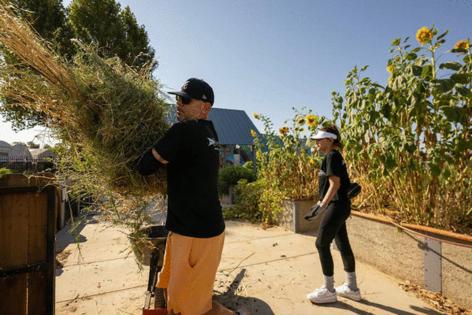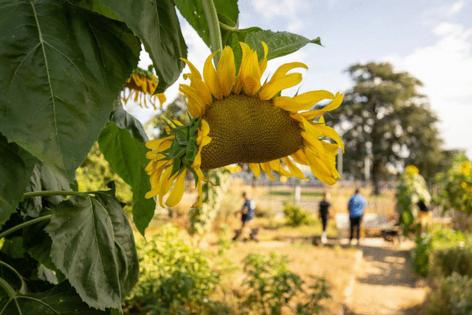Sacramento is building more community gardens. Who will take care of them?
Published in Gardening News
SACRAMENTO — Eight-foot sunflower stalks tower over tracts overrun with weeds. A wooden post marks a habitat for ground-nesting native bees. Near one garden entrance, a tree’s branches droop to the ground, laden with ripe yellow peaches.
Here, in the River District, at the confluence of the Sacramento and American rivers, large green jalapeno peppers, green onions and tomatoes grow in harmony.
The Mirasol Community Garden shows signs of life. But not all plots enjoy this level of caretaking.
“Gardens just don’t happen,” said Joe Robustelli, neighborhood empowerment manager at Alchemist CDC.
To Robustelli, the city has long built community gardens and left them to communities without much additional support, such as classes on how to grow produce. As a result, some gardens have struggled to thrive.
“If you just build the garden, it’s not just going to happen that it gets activated, unless it happens to be in an area where people have a lot of resources at their disposal,” Robustelli said.
Community gardens were a key priority of public input to Sacramento’s Parks Plan 2040, which guides the city’s management of parks over the next two decades. Community gardens, the plan asserts, serve as a tool to address food insecurity and provide healthy, fresh produce to local residents.
The city currently owns 19 community gardens and is in the process of building two new ones — Wood Park Community Garden in Valley Hi/North Laguna and Oakbrook Park Community Garden in South Natomas. The city’s first community garden, which was removed in 2004 from its midtown location, opened in 1971.
Robyn Ayres, a resident of Arden Arcade, has owned a plot at the Mirasol garden for the past two years. She said she led a community garden organization in Indiana for four years before moving to Sacramento.
No community gardens are near her home, Ayres said, so she decided to start making the roughly 15-minute drive to Mirasol because she had acquaintances in the neighborhood.
“I think that community gardens have a wealth of opportunities, from all sorts of things from education about science to art to cooking,” Ayres said.
Blooms and ruins
On an early Saturday morning in July, volunteers pulled weeds from plots and carted them to compost bins in wheelbarrows.
Paola Duarte brought a corporate group of six from her office to volunteer at Mirasol. A technician with Retinal Consultants Medical Group, which has two Sacramento offices and more throughout the state, Duarte said she found Mirasol and Alchemist through a Google search for volunteer opportunities.
“I felt like it was a way to give back,” Duarte said. “I grew up in Sacramento, so I saw this area go through its changes.”
Alchemist took over stewardship of the Mirasol garden when it opened in the spring of 2022 in a public housing complex in the River District serving many low-to moderate-income tenants. Single-resident households are considered low-income in Sacramento if they make less than $60,050 per year, and one-person units at Mirasol Village are available for those making less than $66,000.
The city plans to spend about $460,000 to build the new Wood Park garden and about $350,000 to build the Oakbrook Park garden, according to city council reports on the project contracts. The Wood Park project will include 20 plots and concrete walkways, and the Oakbrook project will include 46 plots. Both gardens will have amenities such as storage sheds, hose bibs for irrigation, and picnic tables.
That may not be enough to activate the garden.
Robustelli had to apply for grants and fundraise more than $30,000 for the garden to “even be operational,” he said, and to provide financial support for low-income gardeners to pay for equipment, drip irrigation infrastructure and plot fees.
The city provides gardens with water, but charges residents $25 annually to reserve a 10-foot-by-10-foot plot and $50 for larger plots. Robustelli said the former community garden coordinator for the city did not respond to his request about how to apply to waive them. According to the current coordinator, William Fredericksen, Mirasol is not eligible.
The city currently hosts free gardening classes and provides tools and water at community gardens, according to Fredericksen. The tools and water, he said, have “always been provided.” A plot fee waiver is available specifically for low-income residents at Seavey Circle due to financial support from city councilmember Katie Valenzuela’s office.
At some of the more popular gardens, such as the Fremont Community Garden in downtown Sacramento, the waitlist for a plot can take up to three years.
However, Robustelli said residents in low-income and underserved areas don’t always have the time or resources to commit to gardens such as Mirasol.
They also may not know how to grow fresh vegetables. A CapRadio/Valley Vision survey in 2021 found that only 60% of African American respondents had had experience or exposure to gardening, which was the lowest out of any racial group surveyed.
Gardens typically stay locked to members of the public who do not own plots to prevent theft, Fredericksen said. On work days, which occur once a month at each garden, any resident may enter and volunteer.
But without sustained care from community members who own plots, gardens can quickly deteriorate or remain largely unused.
Robustelli hopes that the city can partner with nonprofits more often by providing them funding to organize community engagement programs and other efforts toward activating the gardens.
He pointed to the Strauch Park Community Garden in South Natomas as an example of a garden that suffers from lack of maintenance, calling it an “eyesore for the community.”
“It’s really telling that the city would allow it to fall into disrepair like that,” Robustelli said.
Community stewardship
Garden governance can be another point of contention for communities.
Hibiscus, for example, is a staple in various cultures. It is often used in foods ranging from agua de jamaica among Latin American communities to red drink in Black communities.
In the summer of 2023, Robustelli said Alchemist was told gardeners could no longer grow hibiscus in the Mirasol garden. He cited reasons such as the plant’s large size and its encroachment on the pathway near which it was growing.
A gardener attempted to open a conversation with the city gardens coordinator at the time, William Maynard, about the issue because hibiscus was important to him as a culturally relevant food, according to Robustelli.
“The person from the city didn’t seem interested in doing that,” Robustelli said.
The gardener offered to move the plant away from the pathway. Maynard said that the roots would still grow too large and would negatively impact other plants.
Maynard, who retired in January, said that the gardeners never explicitly told him that the hibiscus issue was important to them because it was a culturally relevant food. He said the decision to prohibit hibiscus was based on the plant’s size and said that moving the plant was not an option because it would be impossible to move the root ball in one piece.
Robustelli asked about the possibility of appealing the hibiscus issue to a committee that he had heard oversees policies across all city-owned gardens. He said he was told no such committee existed.
According to city guidelines, a Community Garden Advisory Committee meets monthly to “discuss policies, ideas, garden operations, problems, event planning and plans for the gardens.”
“The city is currently working on an update to the guidelines and will be requesting feedback from gardeners through various methods including in-person listening sessions this fall,” said city spokeswoman Gabby Miller. She said the city expects to complete the revised guidelines by early 2025.
To Robustelli, however, the back-and-forth with the city served as an example of the community’s lack of control over the management of the garden.
“There really needs to be a thoughtfulness behind how the gardens are governed, and a realization that each garden serves a different purpose depending on the community that it’s in,” Robustelli said.
A public priority
On Aug. 1, the city’s Parks and Community Enrichment committee voted to send the draft Parks Plan to the City Council for approval.
Beyond repeated references to community gardens in relation to health and wellness, community building and nature access, the parks plan also explicitly highlights the value of community gardens in quotes from public input sessions.
“I think it brings a lot of beauty to the park, and then it also brings community,” said resident Tanya Mannix about her neighborhood’s community garden at Blackbird Park in North Natomas. “Everybody gets to know everybody.”
Ayres said that she sees value in public gatherings being held in community gardens because it “exposes people to the fact that this is where our food comes from.”
These kinds of community engagement, Robustelli believes, currently fall short.
“The city says they maintain (the gardens), but they really don’t,” Robustelli said. “At the other gardens, they organize volunteer days for the gardeners to come out, and then they’ll haul some stuff away. But other than doing that type of stuff and collecting fees, I’m not positive, really, what a lot of their role is.”
The new community garden at Wood Park is slated to open by the end of November, according to Fredericksen, and the Oakbrook Park garden will open in 2025.
To Ayres, even though it can be difficult for residents to stay committed to caring for their plot in the garden over the course of the year, such gardens are critical spaces not only for food access, but also for community building.
“I think that’s an important part of any city, that people feel connected to one another,” Ayres said.
____
©2024 The Sacramento Bee. Visit at sacbee.com. Distributed by Tribune Content Agency, LLC.













Comments